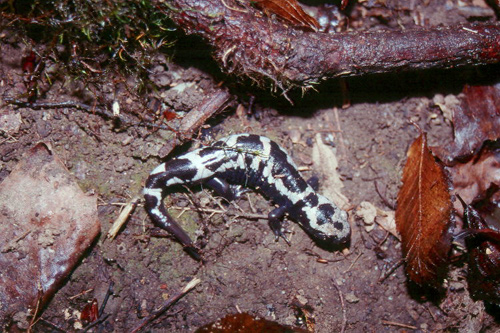The marbled salamander is a member of the mole salamander family, so named because the members of this family spend most of their lives underground. Marbled salamanders are smooth-skinned and black with white marbling on their backs. The black and white contrast is higher on males than on females, and it increases with age. They can be up to 5 inches long.
The range of marbled salamanders is from southern New Hampshire to northern Florida. They extend westewards to eastern Texas and north to Lakes Michegan and Erie. Marbled salamanders are uncommon in Connecticut.
Adult marbled salamanders spend most of their lives under rotting logs and rocks in woodlands. They prefer oak forests. They hibernate over the winter in burrows or tunnels. Marbled salamanders are nocturnal.
Mating season occurs in the late summer and fall when the largely underground-dwelling males and females come to the surface to mate. They mate on land. During breeding, males deposit packets of sperm and females pick up these packets through their cloaca, the opening amphibians use for breeding, egg-laying and waste. Fertilization of her eggs takes place internally. For egg-laying, marbled salamanders use temporary vernal pools that are dry, but will later be filled by rain. Such temporary pools are safer for eggs and young as they are fish-free. The female will lay 50 to 200 eggs on the bottom of the dry vernal pool. She may guard the eggs and curl her body around them to keep them moist until it rains. They hatch into larvae just a few days after they are covered with water. If rain is scarce that fall, hatching may be delayed until the next spring.
The larval stage for these salamanders is aquatic and they have gills. They live in the water while they develop into adults. The metamorphosis to the terrestial, underground adult takes 4 to 6 months.
Adult marbled salamanders eat insects and invertebrates, as do their larvae.
